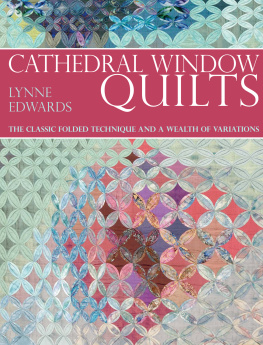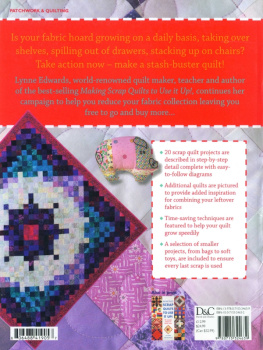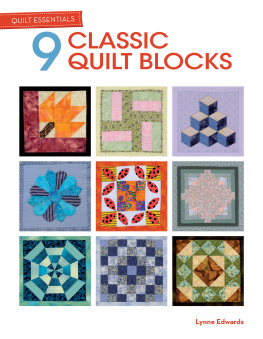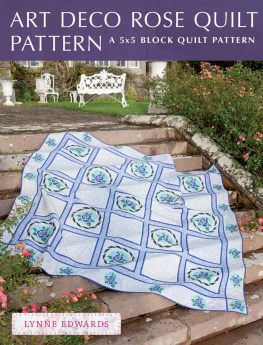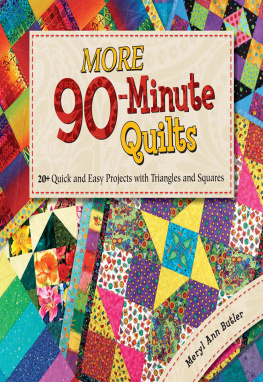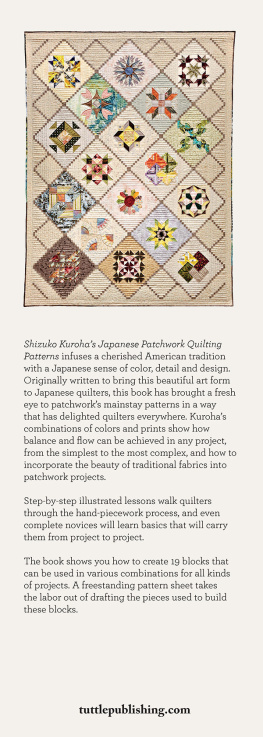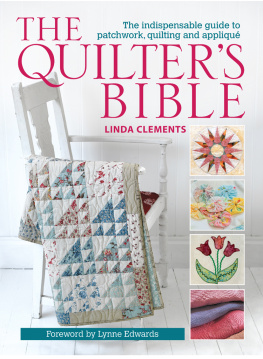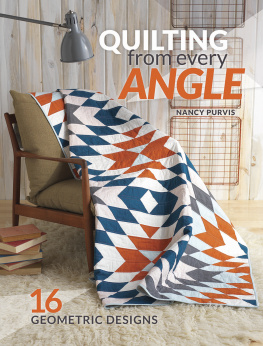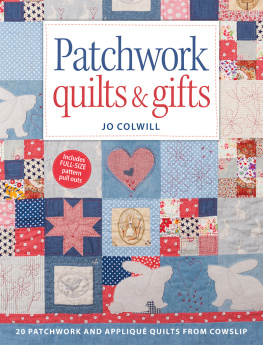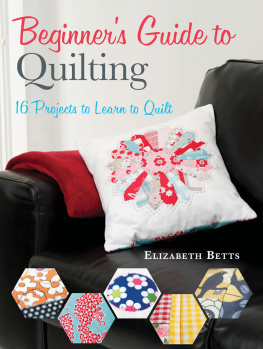Contents
Guide
CATHEDRAL WINDOW QUILTS
LYNNE EDWARDS
THE CLASSIC FOLDED TECHNIQUE AND A WEALTH OF VARIATIONS

www.sewandso.co.uk
CONTENTS
Dedications
This book is dedicated to the memory of Anna Wilson, a wonderful embroiderer and teacher who first introduced me to Cathedral Window many years ago and never told me it was always done with scraps and calico and that it could be difficult, so I flew with it right from the start.
Also to the memory of Tess Simpson and Marian Edwards, two of my Wednesday East Bergholt girls, and also Val Wakefield a Monday girl, all of whom are much missed by us all.
To my family, now expanded to include daughter-in-law Vicky and the Cowan family, who all feel as though they have been part of the family for ever.
And finally, to all those quilters who have been kind or polite enough to ask for this book on my favourite technique and especially to Michael Sarjent from the Home Workshop who has nagged me for years to do it. At last, Michael, at last
Introduction
Cathedral Window is a traditional patchwork technique, usually interpreted in old quilts as rows of folded squares of cream calico with a random arrangement of patterned fabric squares in the windows. It uses about four times its area in the folded squares, so is very greedy of fabric and makes a heavy quilt. Because I use a variety of fabrics and colours for both the folded squares and the overlying windows, I tend to make smaller pieces such as wall hangings, where the subtlety of the designs can be best appreciated.
The first documented evidence of the Cathedral Window design used in a quilt appeared at the Chicago Worlds Fair in the United States in 1933. Possibly its subsequent popularity in the US was partly due to the fact that it needed no backing or borders, and during those Depression years the only fabric most quilters had was a pile of plain cream-coloured corn sacks, which could make the folded squares and a few scraps of coloured fabric which made the windows.
Evidence of Cathedral Window patchwork has been seen more recently in China and Korea, where the design seems to go back several centuries. Aware of my interest in Cathedral Windows, many people have sent me samples and information. Anne Roberts from Sussex has a modern baby carrier that she bought in China which was made using the Cathedral Window design. She also found illustrations in a book on Chinese costume that showed the pattern. Known as the coin pattern, it was a symbol of prosperity and was believed to ward off evil.
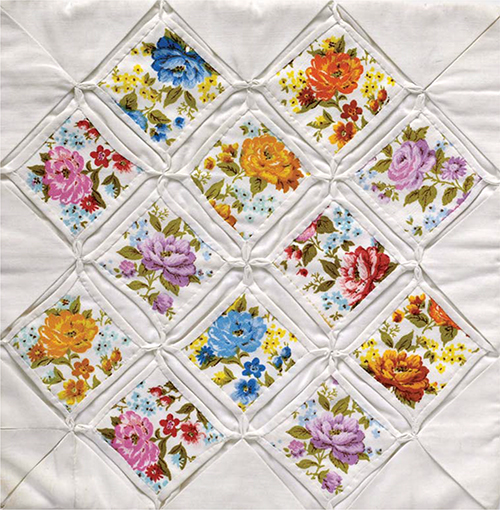
A piece of traditional Cathedral Window from the United States made around 1960, given to me by Susan Harvey from Jersey.
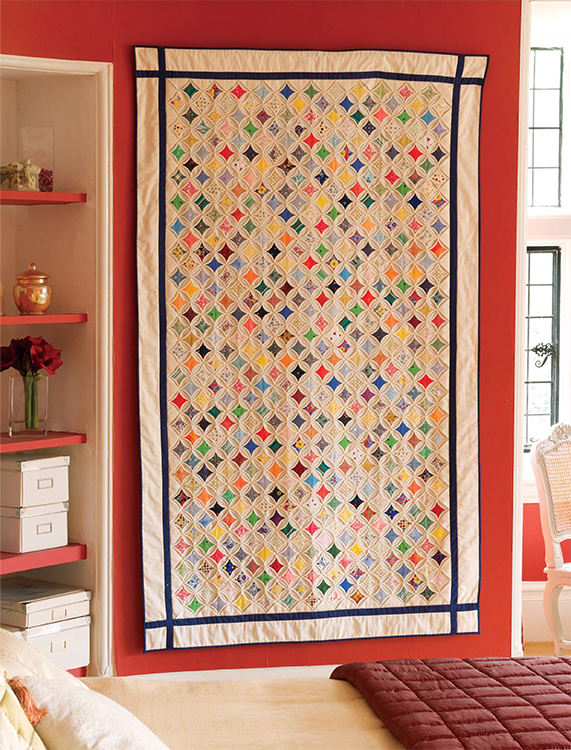
Mandy Lovick started this quilt in 2003 while on holiday. After leaving London for Devon in 2004, their belongings were put into storage, including Mandys sewing machine and fabric stash, so the Cathedral Windows work was re-started while they lived with friends and house hunted. The new home took up much of Mandys time, so she carried on Cathedral-windowing, and one day realized she had enough for a single quilt and here it is.
Angela Chisholm from Edinburgh sent me extracts from a catalogue that accompanied a 1990 exhibition of Korean wrapping cloths. These are decorative cloths called potaji, used in Korea since the 15th century, which are used for wrapping, carrying or covering many objects. The cloths often include patchwork and a technique called ciatamani, which is what we know as Cathedral Window. A photograph in the catalogue shows a detail of one of these cloths, where the method of stitching back the curve the spaced backstitch is the same one that I use. With these two examples of a long tradition of the technique in the East, I wonder whether returning missionaries could have brought it back to the United States or England early in the 20th century. Most peoples idea of Cathedral Window is this traditional one, as can be seen in the little block from Susan Harvey shown on . It is also used wonderfully in Mandy Lovicks bed quilt (see previous page), where a whole collection of scraps begged from friends has been used for the windows and the design framed with a strong blue border strip.
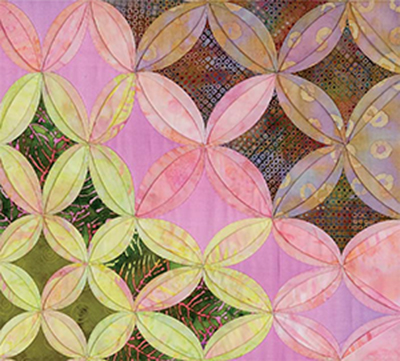
A detail from my Candyfloss wall hanging (see ), a colourful combination of square sand rectangular Cathedral Window blocks in gorgeous batik fabrics.
Using cream calico and scraps is just one approach to this technique. When I made my first Cathedral Window blocks years ago I had never seen a Cathedral Window quilt, so I launched straight into stronger colours and interesting textures. There were no quilt shops in those days offering specialist cotton fabrics, so I used patterned dress fabrics like Liberty Lawns, and for the plain colours went to the polished cotton fabric found in furnishing shops produced specifically as curtain lining. It was pure cotton, very cheap and came in a very wide range of shades. My aim was to use a collection of closely related shades so that I could combine blocks of all of these to creep the colour gently across the quilt rather than have strong contrast and those polished cottons fitted the bill nicely.
Now its a different story. Quilt shops abound with a huge selection of exciting textures, batiks, marbled fabrics, exquisite prints and all in a multitude of colours and tones. How could we limit ourselves to cream calico with all these goodies to choose from?
Using This Book
- See pages for useful information on the basic equipment you will need for Cathedral Window patchwork, plus the marking and cutting techniques required.
- The first section, Classic Cathedral Windows, describes in easy steps how to make a classic Cathedral Window block and I would suggest you begin here to familiarize yourself with the technique.
- This classic Cathedral Windows section is followed by chapters describing variations on that block, such as Secret Garden, Twisted Windows and windows using rectangles. The quilts in these chapters often use blocks based on all these techniques and refer back to earlier sections, to avoid repetition.
- The second part of the book, Keep on Folding, describes techniques similar to Cathedral Window in their appearance but not in their construction. They have the advantage of having raw edges, so they can be used in designs with other more conventional forms of patchwork if desired. They are intriguing and fun to do and if you want to dip into one of these areas rather than tackling Cathedral Window techniques first, thats fine.
- The majority of quilters use the imperial measuring system but metric equivalents have also been given throughout.
- On diagrams, the right side of the fabric is abbreviated to RS and the wrong side to WS.
- All seam allowances are 14in (6mm) unless otherwise stated.
Fabrics for Cathedral Window

